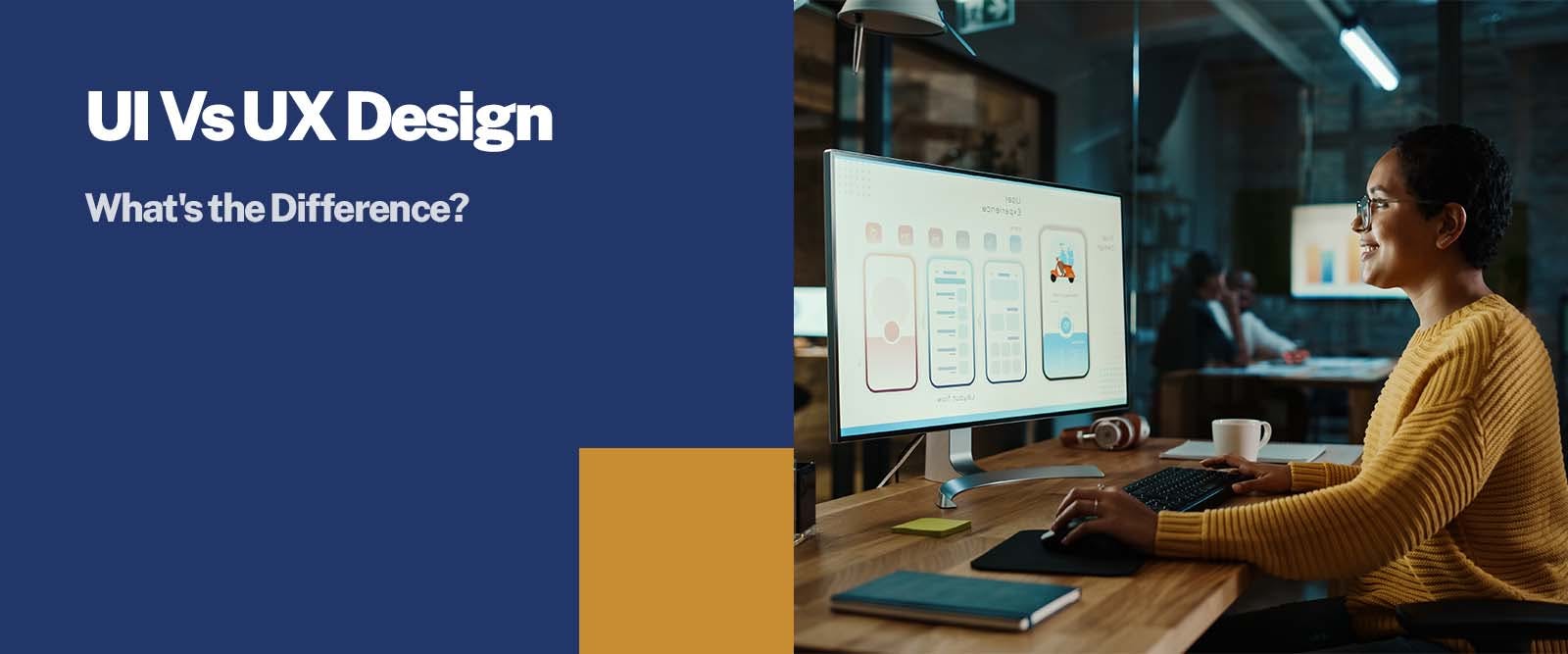5800 students unlocked their dream jobs with UG/PG programs in top colleges. Apply Now!
User Interface (UI) design and User Experience (UX) design are two essential components of creating digital products and services. While they are distinct, they work together to provide a seamless and enjoyable user experience.
Both UI and UX design are crucial for creating successful digital experiences. While UI design is responsible for the visual appearance and interactive elements, UX design ensures that the product is user-centred, intuitive, and provides a positive experience. To learn more about these you can get a professional degree in UI or UX Design. To start with you can go for a B.Tech degree in computer science to learn the mechanics of it.
What is UI Design?
UI design, or User Interface design, focuses on creating visually appealing and intuitive interfaces for digital products or systems. It involves designing visual elements such as colours, typography, icons, and layouts to enhance user interaction and engagement. UI design aims to create an attractive and visually consistent interface that is easy to navigate and understand for the users.
Elements of UI
The elements of UI (User Interface) design encompass various components that contribute to the overall visual and interactive experience of a digital product. Some key elements include-
- Layout
- Colour
- Typography
- Icons
- Buttons and Controls
- Imagery and Graphics
- Navigation
- Feedback and Notifications
- Consistency
- Responsiveness
These elements work together to create an interface that is visually appealing, intuitive and enhances user engagement and satisfaction.
What is the Role of UI Designing?
The role of UI (User Interface) design is crucial in creating a visually appealing and user-friendly interface for digital products. Such as-
- UI design focuses on creating visually pleasing interfaces by carefully selecting colours, typography, imagery, and layout. A visually appealing interface captivates users, makes a positive first impression, and encourages them to engage with the product.
- It strives to strike a balance between aesthetics and functionality, ensuring that users can interact with the product seamlessly while enjoying an engaging visual design.
What is UX Design?
UX design, or User Experience design, focuses on creating meaningful and enjoyable experiences for users when they interact with a product, system, or service. It encompasses various aspects of user interaction, perception, and emotions throughout their entire journey. UX design aims to understand users' needs, behaviours, and goals in order to design intuitive and user-centred solutions.
Key elements of UX design include:
- User Research
- Information Architecture
- Wireframing and Prototyping
- Usability Testing
- Interaction Design
- Visual Design
- Accessibility
By integrating these elements, UX design aims to create products that are not only functional but also delightful, intuitive, and enjoyable to use. It strives to understand and meet user needs, ultimately enhancing user satisfaction, engagement, and loyalty.
Role of UX Designing
The role of UX (User Experience) design is multifaceted and encompasses various responsibilities throughout the product development process.
It aims to create intuitive, enjoyable, and meaningful experiences that meet user expectations, resulting in enhanced user satisfaction, engagement, and loyalty.
Key Differences Between UI vs UX Design
Focus and goals
- UI Design:
- Focuses on the visual presentation and aesthetics of the user interface.
- Aims to create a visually appealing and engaging interface.
- The goal is to provide an interface that is visually consistent, intuitive to navigate, and aesthetically pleasing.
- UX Design:
-
- Focuses on the overall user experience and satisfaction.
- Aims to understand user needs, behaviours, and goals.
- The goal is to create a seamless and meaningful experience that meets user expectations and solves their problems.
Skill sets and responsibilities
- UI Design:
- Proficiency in graphic design, typography, colour theory, and visual communication.
- Responsible for creating visually appealing layouts, selecting appropriate colours and fonts, and designing interactive elements.
- Focuses on the visual aspects and presentation of the interface.
- UX Design:
- Proficiency in user research, information architecture, interaction design, and usability testing.
- Responsible for understanding user behaviours, conducting research, creating user personas, defining user flows, and conducting usability tests.
- Focuses on understanding user needs and designing the overall user experience.
- Collaboration and relationship between UI and UX designers:
- UI and UX designers work collaboratively to create a cohesive and effective design.
- UI design and UX design are interdependent and closely related.
- UI designers rely on UX research and insights to inform their visual design decisions.
- UX designers work with UI designers to ensure that the visual elements support the overall user experience goals.
- Effective collaboration and communication between UI and UX designers result in a seamless integration of aesthetics and usability.
Overall, while UI design focuses on the visual aspects and presentation of the interface, UX design takes a holistic approach, considering the entire user experience. Both disciplines are essential and work together to create interfaces that are visually appealing, intuitive, and provide a satisfying user experience.
Why is it important to distinguish UI and UX Design?
It is important to distinguish between UI and UX Design because many times people think that both these terms are synonymous. But in reality, they are not.
- Differentiating UI and UX design helps define the specific roles, responsibilities, and skill sets required for each discipline. It ensures that there is clarity within the design team and promotes effective collaboration.
- UI and UX design requires different areas of expertise. UI designers focus on visual design, aesthetics, and interactive elements, while UX designers specialize in user research, information architecture, and usability testing. Recognising these distinctions allows organizations to hire and allocate resources accordingly.
The Correlation between UI and UX Design
The interplay between UI (User Interface) and UX (User Experience) design is crucial for creating successful digital products. Although they have distinct focuses, UI and UX design are closely intertwined and rely on each other to deliver a cohesive and effective user experience. Here are key aspects of their interplay:
- UI and UX designers collaborate throughout the design process. They work together to align the visual elements with the overall user experience goals.
- UX design provides the foundation for understanding user needs, behaviours, and goals. This understanding guides the design of the UI.
- The visual elements designed by UI designers should align with the user flows and interactions defined by UX designers.
- Throughout the design process, UI designers may identify usability issues or opportunities for visual enhancements, which they communicate to UX designers. Conversely, UX designers may gather feedback from users that informs UI design decisions.
- The interplay between UI and UX design fosters a shared understanding among the design team.
In summary, the interplay between UI and UX design is a collaborative and iterative process that ensures a harmonious and effective user experience. By working together, UI and UX designers leverage their respective expertise to create visually appealing interfaces that meet user needs, enhance usability, and deliver a satisfying user experience.
Conclusion
In conclusion, UI and UX Design are two very complementary fields of technology. Students who are passionate about designing and aspire to make a career in design can go for this course. For the technical upper hand, you can choose colleges powered by Sunstone to get a B.tech degree with a specialisation in UI and UX Design. With Suntone you can get 70+ training and development sessions. You can learn to make a professional portfolio to get noticed by a wide range of recruiters.
FAQ - UI Vs UX Design
What are the main goals of UI design?
The main goals of UI design are to create a visually appealing and engaging interface, ensure consistency in the visual elements, and provide an intuitive and aesthetically pleasing user experience.
What are the skill sets required for UI design?
UI designers need skills in graphic design, typography, colour theory, visual communication, and proficiency in design tools and software.
What are the skill sets required for UX design?
UX designers need skills in user research, information architecture, interaction design, usability testing, data analysis, and proficiency in UX design tools and software.
Can one person handle both UI and UX design?
While some designers may have skills in both UI and UX design, it is common for UI and UX design to be handled by separate individuals or teams due to the specialized nature of each discipline. Collaboration between UI and UX designers is essential for creating successful products.
HELP
Take the first step towards your dream job.
ABOUT THE AUTHOR

